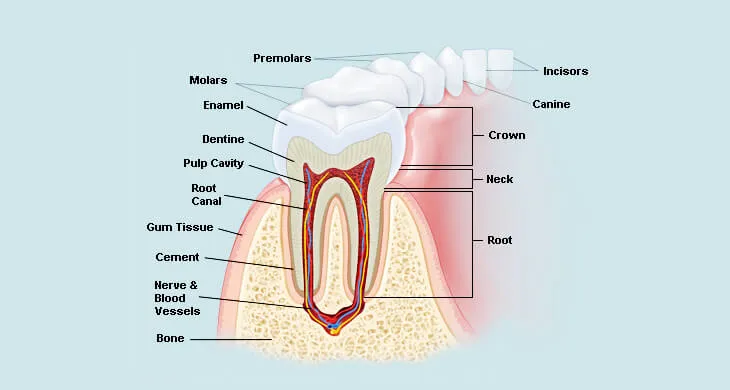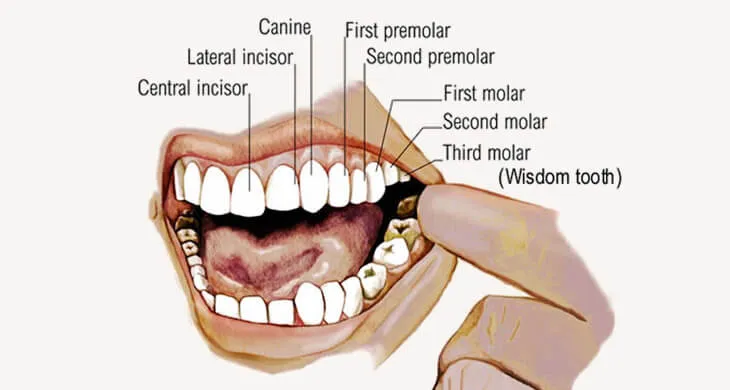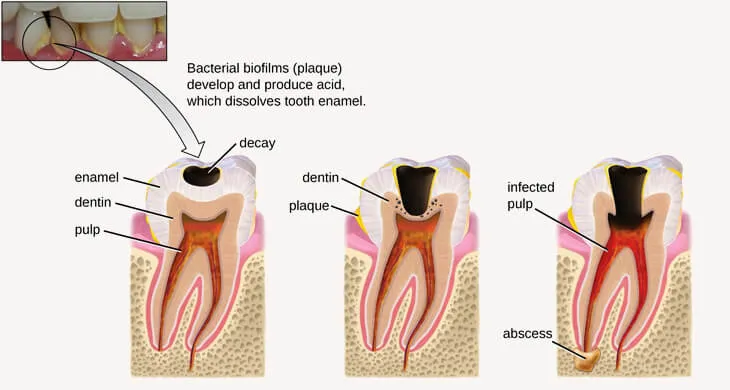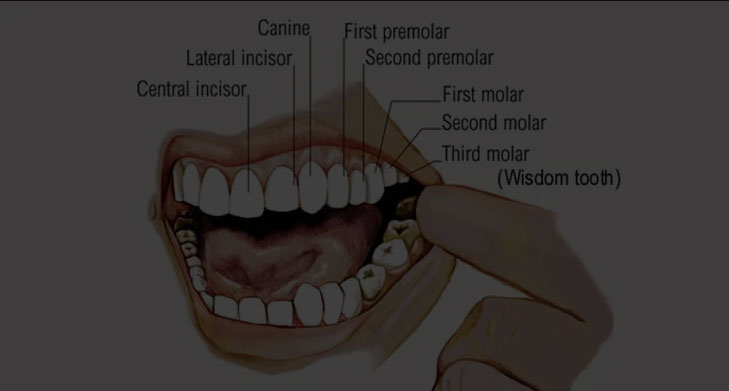Human Teeth Parts, Facts, Diseases, Diagram, Structure and Functions
In This Article You Will Know:
- How many teeth does a typical adult have?
- What are the teeth functions other than biting and chewing food?
- By what age an adult has grown all the 32 teeth?
- When do the wisdom teeth grow?
- Which is the longest part of the tooth?
A tooth can be described as a hard, bonelike structure anchored in the jaws of most vertebrates and primarily used for biting, grinding, chewing and crushing food. Did you know your teeth also perform several other functions for you?

Fig. 1: Teeth Diagram
Like the pancreas, liver, gallbladder, salivary glands, and tongue, the teeth are the accessory digestive organs. They particularly help chop up food, thus increasing its surface area for the digestive enzymes to act on. In addition to breaking down food, the teeth also help you pronounce words accurately. They also help you look better by giving you a good profile. Did you ever imagine your laugh will lose its charm in the absence of teeth in the mouth? These natural pearls are one of the greatest blessings of nature!
Here you will learn about the human teeth parts, facts, diseases, diagram, structure and function.
The Teeth in Brief:
How many teeth does an adult have? What makes teeth so firm and strong? There are 32 teeth in total in a typical human adult, housed in a mucosa-lined chamber or cavity, called the mouth. Deep sockets in the jawbone provide anchorage to the teeth,which is reinforced by strong periodontal fibres and cementum, which acts as a ‘natural glue’.
The root and the crown are two major parts of the teeth. The root is that part of a tooth that is fixed into the jawbone and covered by gums. On the other hand, the crown is a clearly visible part of the tooth that projects above.
Types of Teeth and Their Function:
How many types of teeth are there? Four or five? They are of five types, namely, incisors, canines, premolars, molars, and wisdom teeth.
The book “The Facts on File Illustrated Guide to the Human Body”, a project of TBD, Diagram Group, discusses the shape and function of teeth with diagrams. It says that each type of teeth has a different shape and function and that all of them are involved in the process of mastication. Mastication or chewing is a form of mechanical digestion.

Fig. 2: Types of Teeth
Here follows a brief overview of different types of teeth along with their function.
The Incisors:
The incisors are the middlemost four teeth on each jaw. Shaped like a chisel, they have sharp edges. Their job is to bite into and cut the food to prepare it for swallowing and digestion.
The Canines:
Also called cuspids or eyeteeth, these are sharply pointed teeth shaped like a cone. They are four in number (two in each jaw) and are located just outside the incisors. You use them to grasp, shred, and tear the food being masticated in the mouth.
The Premolars:
The premolars or bicuspids have flat surfaces with two distinct edges. They are found between the canines and the molars. Their job is to grind the food. Each of your jaws houses four molars.
The Molars:
The molars are twelve in number. Located in the rear of the mouth, these flat teeth provide maximum surface area for crushing and grinding food.
The Wisdom Teeth:
Also known as third molars, these are the vestigial teeth that helped the ancestors of humans to grind plant tissue. While the age at which they erupt is variable, the wisdom teeth usually grow at around age 18. They are likely to cause displacement of other teeth. Therefore, dental surgeons advise their surgical removal.

Fig. 3: Wisdom Teeth
Teeth Diagram:
The teeth diagram helps you learn about the shape and location of different types of teeth. It shows that each side of your mouth houses eight teeth of different types in each jaw (lower and upper). Two of them are incisors, one canine, two premolars, and three molars. It means each jaw supports four incisors, two canines, four premolars, and six molars, thus taking the total count to 16.
Teeth Parts:
In the teeth diagram, you can also distinguish between different parts of teeth, especially, the crown, the neck and the root. Here follows a list of different parts of a tooth as described by dental anatomists.
The Crown:
The uppermost part of a tooth is called the crown. It is the only part of the teeth that you can see. The shape of the crown determines the job of the given tooth. For example, the flat surface of molars suggests that they would be used for grinding food.
The Neck:
The part of a tooth joining the crown with the root is called the neck.
The Root:
Forming the lowermost part of a tooth, the root provides anchorage into the jaw. The largest part of a tooth, the root accounts for about two-thirds of it.Covered by gums, it is embedded either in the mandible (lower jaw) or the maxilla (upper jaw).
The Enamel:
The hardest and the most mineralized tissue in your body, the enamel forms the outermost layer of the teeth. If teeth are not properly cared for, the enamel may experience damage and decay.
The Dentin:
The layer of the teeth located just below the enamel is called the dentin. It houses millions of tiny tubes that directly lead to the dental pulp. The damage or decay progressing through the enamel may also affect the dentin layer.
The Gumline:
The gumline provides a meeting point for the gums and the teeth. If you do not properly brush and floss the teeth, it will lead to the build-up of tartar and plaque at the gumline. Such a condition may cause gum disease and gingivitis.
The Dental Pulp:
It is the soft tissue found in the centre of your teeth. As nerves and blood vessels run through this living inner structure of a tooth, the decay of dental pulp causes a sensation of pain.
The Cementum:
It is the layer of connective tissue that binds the root of a tooth to the gums and jawbone.
The Periodontal Ligament:
The periodontal ligament is a tissue that is used to tightly hold a tooth against the jaw.
Teeth Diseases:
Different teeth conditions include cavities, plaque, tooth decay, tartar, underbite, overbite, tooth sensitivity, bruxism, gingivitis, and periodontitis.

Fig. 4: Teeth Diseases
Cavity Formation:
Cavities result from the tooth decay which can affect both the enamel (outer coating) and dentin (inner layer) of a tooth. Most cavities are formed in the molars and premolars.
Diagnosis:
Presence of cavities causes toothache, especially after eating or drinking something sweet, cold, and hot. While diagnosing cavities, your dentist may look for soft spots or use X-ray to probe between the teeth. Sometimes, you can find it for yourself the holes or pits in the teeth.
Causes:
Did you know what causes tooth decay? It results from the activities of bacteria which evade removal by saliva and brushing. When the remains of foods like bread, milk, candy, cake, cereal and fruit stay on the teeth, bacteria turn them into acids. The acids, food debris, saliva and bacteria later combine to create plaque, which gets stuck to the teeth. The acid constituent of the plaque dissolves the enamel and dentin, thus creating holes which you call cavities.
Treatment:
Depending on how bad the cavity is your dentist may prescribe appropriate therapy. They may either remove the decayed portion with a drill or fill in the hole with a composite resin, porcelain, silver alloy and/or gold.
Tooth Sensitivity:
One of the common tooth conditions, sensitivity is characterised by painful or hurting teeth when hot or cold drinks pass over them. Things like sour or sweet foods and even cold air can aggravate the condition.
Diagnosis:
If consuming hot or cold drinks or foods hurts your teeth and causes a sensation of pain, you are likely to have tooth sensitivity. Moreover, exposure of the teeth roots due to some underlying condition may also serve as a sign of sensitive teeth.
Causes:
Sensitivity occurs when the inner layer or dentin of a tooth is exposed. The exposure of dentin may result from various factors, including naturally shrinking gums, gum disease,and a cracked tooth or filling, etc. As you get over 40, natural wear and tear may pull away gums and uncover the tooth roots. Similarly, the build-up of tartar and plaque can also make the gums pull back.
Treatment:
For the treatment of tooth sensitivity, your dentist needs to find out the underlying problem. They can afterwards suggest one of many available ways to help ease your pain. For example, they may prescribe the use of fluoride gel, desensitizing pastes, sealants, fillings, toothpaste for sensitive teeth and mouthguard to protect teeth if you grind.
Bruxism
Also called teeth grinding, bruxism does not usually cause harm when occurring occasionally. When people grind their teeth on a regular basis, it may damage their teeth and cause other oral health complications.
Diagnosis:
Abnormal teeth grinding often occurs during sleep. That is why most people remain unaware that they are suffering from bruxism. The patient usually learns from others about the condition. Just talk to your dentist if you are told you grind your teeth during sleep. They will examine your teeth for signs of bruxism, like excessive wear on your teeth and jaw tenderness.
Causes:
Occurring usually during sleep, teeth grinding may result from sleep disorders, anxiety, and stress. It may also occur due to an abnormal bite, and crooked or missing teeth.
Treatment:
Is grinding your teeth harmful? Chronic teeth grinding can lead to loosening, fracturing or even loss of teeth. It may also wear teeth down to stumps. When such a thing happens, you may need crowns, bridges, implants and partial or complete dentures.
How to Stop Grinding Your Teeth:
Use of a mouth guard can help you stop grinding your teeth during sleep. In case bruxism is due to stress, anxiety or a sleep disorder, ask your healthcare provider or dentist to diagnose and treat the underlying condition.
There are also some practical tips to help you stop teeth grinding, such as cutting back on caffeine-containing foods and drinks, avoiding alcohol and chewing gum, etc.



